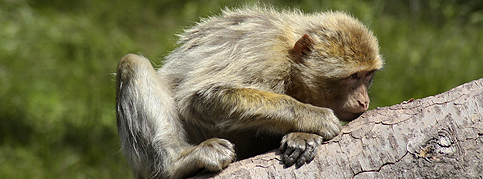Barbary apes.
The rulers of the rocks on the Mediterranean
Directly to the left of the entrance to the Wildlife Park you will find the area where a large group of Barbary apes (macaca sylvanus) live. Barbary apes are part of the macaque family and are also called magots. Alongside humans, they are the only free-living primate species anywhere in Europe. Unfortunately, their natural habitat is being increasingly destroyed by humans – which is why Barbary apes are on the list of endangered species.
Characteristics
Barbary apes grow to between 45 and 70 centimetres and can live to between 20 and 30 years old. Their soft fur is yellow-brown or grey-brown. Weighing in at between 7 and 15 kilograms, the males are considerably heavier than the females, which usually weigh between 5 and 9 kilograms. Barbary apes belong to the cercopithecinae subfamily, which use their cheek pouches to carry food around in.
Area of origin
Barbary apes originally come from Gibraltar and North Africa (Morocco, Algeria). There they form large family groups of up to 60 animals that are led by a dominant male. In higher, more isolated forest regions they spend most of their time on the ground, but they are also skilled climbers. Males and females share childcare responsibilities and both defend them from predators.
Diet
As omnivores Barbary apes eat leaves, roots, fruit, buds and insects. Sometimes they also catch spiders and scorpions. In the winter tree bark and twigs feature prominently on the menu.
Conservation status
Today around 240 Barbary apes still live in Gibraltar and about another 10,000 live in North Africa. Barbary apes also used to live in Libya and Egypt, but were eradicated there as early as 1800. In Morocco and Algeria, too, destruction of the environment means that the natural habitat of this primate species is increasingly shrinking. That is why today Barbary apes are considered to be severely endangered.
At home between the continents!











